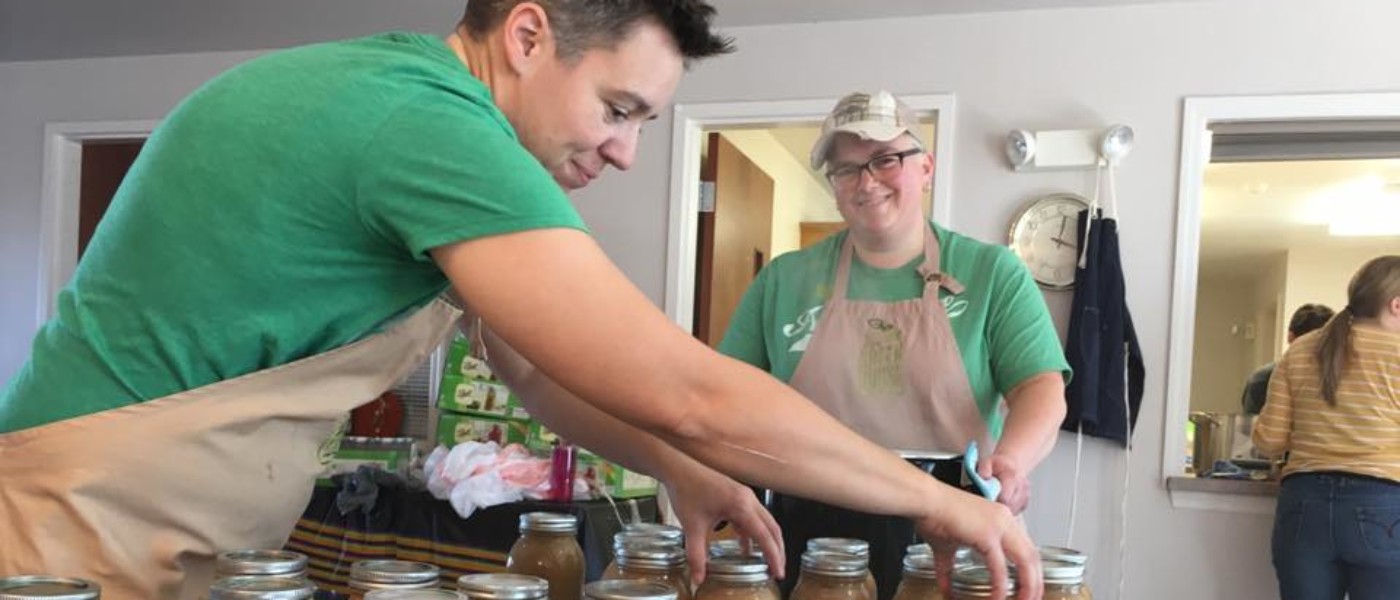This 101, on how to start a food recovery program, comes from Ashlee O. Shelton, founder of The Greenhouse, in Harrisburg, Pennsylvania. Where some food recoveries focus on salvaging unsold food from restaurants, the Greenhouse collects its food from local farmers — and then does one better. To extend the life of this good food, Ashlee and company preserve, can, pickle, and freeze it, capturing precious nutrients at their peak before redistributing their efforts to Harrisburg’s underserved citizens. How’s that for going the extra mile? Read on for tips on how to start your own program. And kudos, Ashlee. We’re in awe.
What is the Greenhouse?
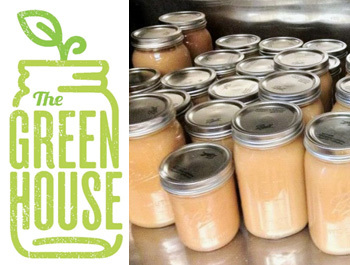
The harsh reality is that, in the United States, 40 percent of our available food is thrown away, while more than 17 million households lack food security. Clearly there are cracks in the food system. The Greenhouse is searching for ways to start fixing those cracks and to help build a viable and accessible food infrastructure.
Located in Harrisburg, Pennsylvania, the Greenhouse is an organization dedicated to transforming our community from a food desert into a food oasis by recovering food that otherwise would have been wasted, preserving it in healthy and creative ways (canning, freezing, dehydrating, etc.), and then distributing it to those who might not get it otherwise. Where some food recovery programs focus on collecting and redistributing unused food from restaurants, we primarily collect unsold food from area farmers.
A food desert is an area with little or no access to healthy and nutritious food, and a large part of the Harrisburg area fits into this category. Not sure which areas are the most food insecure? Check out the USDA’s Food Access Research Atlas. This tool shines a light on hidden hunger across the United States and will help you set your sights on the places that could benefit most from a food recovery program.
Ashlee’s Story: Why Food Recover Matters
When I was a high school student, I began volunteering as a tutor in a low-income neighborhood in Harrisburg. I grew up right across river, but that river served as a proverbial railroad track dividing wealth and race and ethnicity in the Harrisburg area. Where I tutored was just two miles from my home, but it felt like a completely different world.
A trip to a Navajo reservation around that same time furthered my understanding of poverty. There, it wasn’t a body of water dividing the resources but an invisible line drawn in the sand by Manifest Destiny. The following years introduced me to all kinds of groups working to fight poverty: radical Christians who staged sleep-ins on the sidewalks of Philadelphia, protesting the police department’s efforts to sweep the homeless out of view; Vietnam veterans and a growing movement for peace; and a homeless advocacy effort in Albuquerque that served people addicted to heroin and those fleeing violence, living on the streets, experiencing the recidivism of the prison industry, and struggling to stay alive.
Back near my family in the Northeast, I needed an outlet and a community where I could put my newfound awareness of poverty and power and injustice to action. I founded the first Harrisburg chapter of Food Not Bombs in 2003. We started collecting food from big-box grocery stores by the vanful on a weekly basis. The amount of food we recovered in one small American town was overwhelming. We cooked the food in our home kitchens, a Catholic Worker House, an ACORN office, and outside on camping stoves.
Food Not Bombs’ philosophy is that food is shared, not served. It’s not a charity; it’s a way of life. In some parts of the country, it’s also an act of civil disobedience. To share food that has been discarded makes the statement that there is another way to do things. As a group, we felt that by cooking food that otherwise would have been thrown in the dumpster, we were making a statement against the violence of poverty.
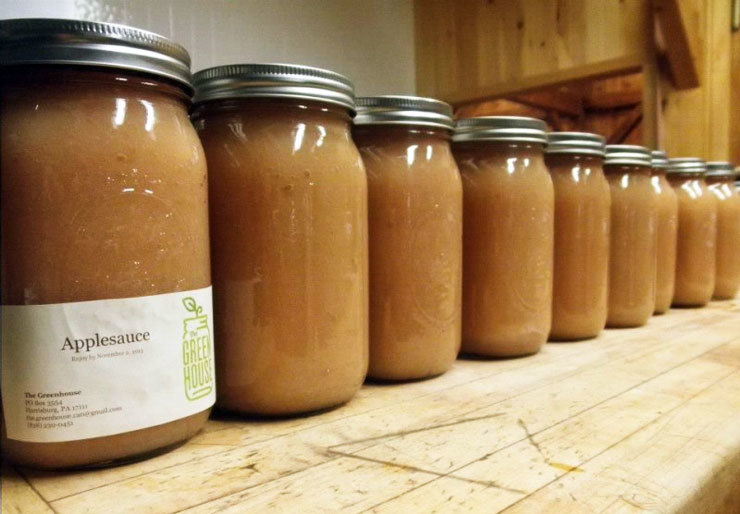
And So, the Greenhouse Was Born
The Greenhouse grew directly out of these experiences. Some friends and I started getting together once a week on the night we picked up our CSA shares. We began cooking as a group on those evenings of abundance and called the gathering Farm Nights. Discussions about sustainable farming and food access became a regular part of those evenings, and plans for the Greenhouse began to unfold. One of the key differences from our work with Food Not Bombs was the addition of a food preservation element. By preserving food through canning, freezing, and dehydrating, we hypothesized that we could add a 365-day shelf life to healthy, local, and fresh foods that otherwise would have not been used to nourish people.
We have learned that there are other organizations doing similar work, and we strive to share our own ideas and incorporate many of theirs as we grow and expand our reach. Recently featured on TEDx, the Farm to Freezer project in Bethesda, Maryland, is a fantastic example. Being from and working in Pennsylvania, we also have access to the Pennsylvania Association for Sustainable Agriculture (PASA). PASA offers its members a wealth of networking and educational opportunities. I recommend seeking out similar organizations in your state or region.
How the Greenhouse Works (I.E., Steal this Recipe and Start Your Own Food Recovery Program)
1. Set the stage (a.k.a. get folks excited and gather resources)
Since we don’t have a physical location, we have to rent commercial kitchen space. In order to make that financially possible, we threw a fundraiser and equipment-gathering endeavor early on called Stuff the Bus. This event served as a way to educate the community about the need we had identified and afforded us the chance to engage potential volunteers in person. I believe this event gave us a platform to explain our ideas in a way that enticed folks to participate in the hard work to come.
We held Staff the Bus at a local park and decked out the basketball court like a house. Bobbi Carmitchell, a fantastic local musician, sang from the living room; folks enjoyed sweet potatoes and homemade vegetarian chili in the dining room; and we had overflow seating on the back porch, under the clothesline, and next to the fire ring. Attendees brought cases of canning jars and other canning equipment, and we stuffed our trusty Greenhouse school bus to the gills.
2. Identify recipients
We agreed from the beginning that we wanted to donate the food we collected to direct-service providers in our community. The organizations we choose to support serve people within the food desert but do not limit their service recipients to subscribers of any particular religion. One of our group members works in the mental health field and knows all too well about the linkages between that issue and food insecurity. She recommended Shalom House because she saw firsthand the important services they offer. In addition to serving as a shelter from domestic violence, Shalom House also provides a transitional housing program for female veterans and their children who are experiencing homelessness. We also share food with the Boys and Girls Clubs of Harrisburg and the St. Francis of Assisi Soup Kitchen. The Greenhouse remains open to suggestions and has a number of events slated to serve new, as well as repeat, organizations.
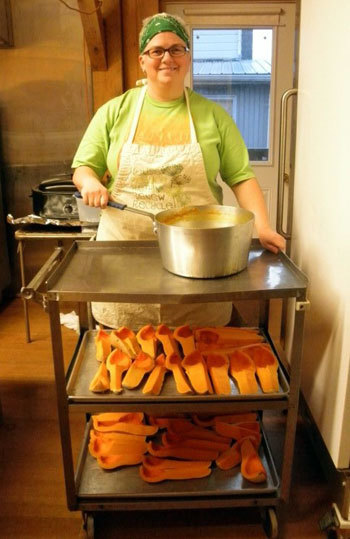
3. Find a kitchen
We worked at the Village Acres Farm Food Shed in Mifflintown, Pennsylvania, for our first two preservation events. Village Acres is a certified organic CSA that has a unique — and desirable — community space. Because we were using the space for an awesome cause, they allowed us to rent the kitchen at a discounted rate. The Greenhouse was very fortunate to have access to their environmentally friendly facility, and their staff even gave our volunteers tours of the farm via hayride!
4. Network with and learn from farmers
Early on in the process, we realized that, while we had a great idea and good intentions, we certainly were not experts on farming or what goes into supporting a farm’s gleaning efforts. So, we asked a lot of questions and learned as we went. For the first two events, we relied on donations of vegetables and fruits from farmers. In the near future, we plan to start mobilizing gleaning teams to go to farms and collect the fallen crops. The farmers we’ve been working with seem to be grateful to have an outlet where they can contribute their unsold produce. They’ve also been an abundant source of suggestions and education, especially on effective timing for our projects.
5. Rally support
We were able to drum up substantial financial and volunteer support through an online publicity campaign. Since we don’t have a Greenhouse website yet, we rely heavily on our Facebook page. We also had enormous success with Smore.com’s online flyers, which you can seamlessly sync with other social media outlets. We’ve submitted our events to online community calendars and online news services; the ideal timing for such calendars is six to eight weeks prior to the event date. We also sent links to our online flyers to a variety of like-minded community groups and asked those groups to distribute our event info to their email lists. We sent out traditional media advisories one week prior to each event, as well as press releases on the morning of each event.
We’ve secured volunteers though all of the above channels, too. Typically volunteers can choose between shifts we lay out ahead of time. This system assures our volunteers that their time is valuable and lets them know in advance what tasks we need help with. We also lucked out in finding two top-notch graphic designers who work with us pro bono. People are amazingly generous, I tell you. Sometimes you just have to ask for help! Some examples of our volunteer tasks include:
- sorting/cleaning
- cutting
- cooking
- canning
- storage/delivery
6. Preserve the food
There are a few different options as far as what types of food-preservation methods you can use. We chose to cook and can applesauce in early November and called the event Yes We Can. In mid-January, we made a delicious squash soup and prepared it for freezing at an event called Squash Hunger. Dehydrating would also be an option, though we haven’t tried it yet. Because no one in our core group considered themselves a “master canner,” we reached out to a number of folks who had expertise and insight to share. We also did a lot of research and practiced some recipes and canning techniques at home and during Farm Nights.
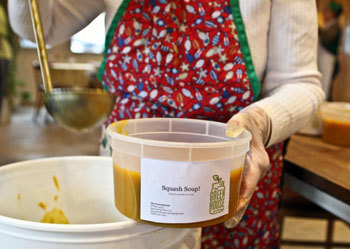
Don’t Get Intimidated
Do Read Widely and Ask for Help
You might notice a theme in these experiences: We didn’t start out as experts in any of the above-mentioned tasks. Not everyone in your group needs to be a food expert, a canning guru, or a marketing professional—but a willingness to reach out to folks who have those skills is key. We found that being honest about our gifts as well as our limitations allowed us to expand our volunteer base in a way that made the most sense.
We also read. A lot. Some of our favorite topics include books about canning and feminism and gardening and justice and cooking and peace and homesteading and starting a revolution. I encourage everyone to try a food preservation event. Focus on community. Break the chains of the charity model and ask WHY some of your neighbors don’t have access to healthy food. Understand that TOGETHER is the only way we can fill in the cracks in our food system and build something that works.
Moving Forward
What’s next for the Greenhouse? We’re currently collaborating with local churches, schools, and community centers to expand our access to cooking facilities. We plan to have a number of events this summer and fall, including a salsa canning party, a zucchini bread baking and freezing shindig, and even more applesauce!
We also plan to take our operation mobile. Even though we don’t have a permanent cooking location, we are very fortunate to have access to some great kitchens in our area. A few of us even have our bona fide food-handling certification—an important detail, depending on licensing requirements in your area. And remember that trusty bus we stuffed to the gills with our first round of canning supplies? Well, we call her Karma Chameleon, and we have some ideas about how to convert her into a mobile grocery store and/or sliding-scale-locally-gleaned-sourced-food truck. Stay tuned!
